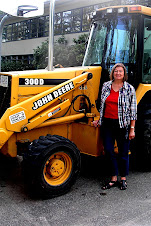Saturday Travel Feature
Bet She'an, Israel
"The City of Bet She'an stratregically situated at the crossroads of major highways that stretched between the Mediterranean, Damascus and the north, and between Jeruselem and the Galilee, played an important role in the early history of the country.
"Archiologists have uncovered about twenty layers of civilization at the Bet She'an mound. The city was founded in the fifth millenium B.C.E., on the banks of a small river, Nahal Herod, between the fifteenth and twelfth centuries B.C.E. It served the Egyptians as an important stronghold. During the 11th century it was held by the Phillistins who, after defeating the Israelites in battle, displayed the bodies of Saul and his sons on the city walls.
King David conquered Bet She'an from the Phillistines and King Solomn made it one of his administrative centers.
"In the Hellenistic Period it was given the names Sythopolis, City of the Sythians, and Nysa for Dionysos nurse. (Dionysos was the chief god of the city, and according to tradition his nurse was buried here.) The inhabitants also preserved the ancient name Ben She'an. The population of the Roman city was mixed, and included Pagans as well as Jews and Samaritans. When Christianity took hold in the fourth century C.E., most of the inhabitants converted to Christianity, although sizable minorities of Jews and Samaritans remained. In the early fifth century C.E. Bet She'an became the capitol of the province called Palaestina Secunda, with an estimated population of 40,000. In the seventh century the city passed into the hands of the Muslems, and in the mid eighth it was destroyed by an earthquake. Bet She'an never quite recovered its former splendor and importance. The Crusaders fortified this important crossroads by building a Citidel here. From then through to the end of the British mandate, Bet She'an had a small but unbroken chain of settlement. With the establishment of the State of Israel the city began to flourish once again.
"Through the ages Bet She'an expanded over a large area and the ancient mound became its acropolis. At the height of the city's importance, during the Byzantine Period, it was surrounded by a wall four kilometers long. The archeologican remains, the majority of which are from the Roman and Byzantine Periods, reveal the magnificance of this ancient metropolis."(See Reference.)
Photo: Taken of Bet She'an, Israel in 1992 by SW. Suzanne and her high school friend Diane joined a tour of Baptist ministers from Mississippi and Georgia for ten days in Israel.
Reference: This quote is from the sign posted at the site of the Bet She'an ruins seen in the photo.
Link: http://en.wikipedia.org/wiki/Beit_She'an
Bet She'an, Israel
"The City of Bet She'an stratregically situated at the crossroads of major highways that stretched between the Mediterranean, Damascus and the north, and between Jeruselem and the Galilee, played an important role in the early history of the country.
"Archiologists have uncovered about twenty layers of civilization at the Bet She'an mound. The city was founded in the fifth millenium B.C.E., on the banks of a small river, Nahal Herod, between the fifteenth and twelfth centuries B.C.E. It served the Egyptians as an important stronghold. During the 11th century it was held by the Phillistins who, after defeating the Israelites in battle, displayed the bodies of Saul and his sons on the city walls.
King David conquered Bet She'an from the Phillistines and King Solomn made it one of his administrative centers.
"In the Hellenistic Period it was given the names Sythopolis, City of the Sythians, and Nysa for Dionysos nurse. (Dionysos was the chief god of the city, and according to tradition his nurse was buried here.) The inhabitants also preserved the ancient name Ben She'an. The population of the Roman city was mixed, and included Pagans as well as Jews and Samaritans. When Christianity took hold in the fourth century C.E., most of the inhabitants converted to Christianity, although sizable minorities of Jews and Samaritans remained. In the early fifth century C.E. Bet She'an became the capitol of the province called Palaestina Secunda, with an estimated population of 40,000. In the seventh century the city passed into the hands of the Muslems, and in the mid eighth it was destroyed by an earthquake. Bet She'an never quite recovered its former splendor and importance. The Crusaders fortified this important crossroads by building a Citidel here. From then through to the end of the British mandate, Bet She'an had a small but unbroken chain of settlement. With the establishment of the State of Israel the city began to flourish once again.
"Through the ages Bet She'an expanded over a large area and the ancient mound became its acropolis. At the height of the city's importance, during the Byzantine Period, it was surrounded by a wall four kilometers long. The archeologican remains, the majority of which are from the Roman and Byzantine Periods, reveal the magnificance of this ancient metropolis."(See Reference.)
Photo: Taken of Bet She'an, Israel in 1992 by SW. Suzanne and her high school friend Diane joined a tour of Baptist ministers from Mississippi and Georgia for ten days in Israel.
Reference: This quote is from the sign posted at the site of the Bet She'an ruins seen in the photo.
Link: http://en.wikipedia.org/wiki/Beit_She'an

